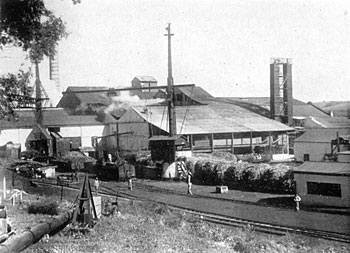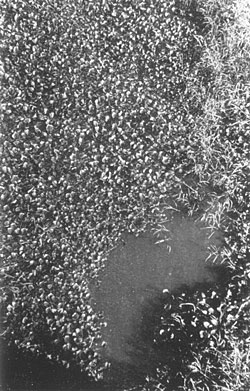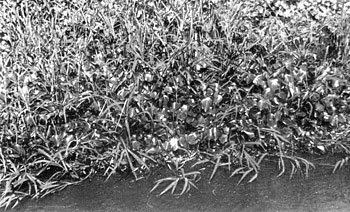Appendix B, "Soil Fertility and Sewage -- An account of Pioneer Work in South Africa in the Disposal of Town Wastes" by J.P.J. van Vuren, with a foreword by Lady Howard, 1949, Faber & Faber, London.
Dedicated
To the first ten inches of soil.
Historical
The water-hyacinth (Eichhornia crassipes) is a true water plant and floats by means of spongy petioles. Of all the aquatic plants the water-hyacinth is the most prolific and spectacular. It was first introduced into the United States from Venezuela and exhibited at the New Orleans Cotton Exposition in 1884. Garden-lovers sought this botanical curiosity and set them in pools and ponds. Very soon the plants escaped their garden bounds and infested the streams and bayous, with the result that for the past forty years many thousands of pounds have been spent in trying to keep in bounds this navigational nuisance.
The plant propagates itself from tiny root fragments, which break off from the large plants and quickly develop leaf stalks and broad green leaves. Runners also grow along the water surface from the base of the petioles, resulting in a rapid spread of vegetative reproduction.
Until very recently the literature had little good to say about this 'curse of the waterways'. Thus Evart, writing about the weeds of Victoria (vide Horticultural Abstracts II, 1941, p. 226), says: 'The water-hyacinth has been used as a manure, but is very bulky and rots quickly, so that it only has a slight and temporary value in adding humus to the soil.'
In Bengal (News letter on Compost, Oct. 1945, p. 69. 221) farmers were persuaded to turn the water-hyacinth into a composted manure. Analysis of random samples of the compost showed a nitrogen percentage of 1.12 on a dry basis.
The potentialities of this plant were first fully recognized by Sir Albert Howard. In his recommendations to the Auckland Municipality he emphasized the necessity for the complete utilization of all city wastes. After describing the methods of screening the solids, and thereafter drying and composting with city wastes, he says: 'After the sludge is filtered off, the clear effluent will contain valuable plant food in solution. This can be trapped by the water-hyacinth. The clear sewage effluent, together with the storm water, should be led into some local stream, river or low-lying area, where the water-hyacinth can be cultivated as a crop, and the clear water (now deprived of most of its plant food) allowed to escape into the sea. On the banks of the areas producing this water-weed, composting centres should be set up and the weed systematically converted into humus, using as an activator a portion of the dried sewage sludge.'
Howard thereupon asked me to carry out a chemical investigation into the matter. The prospects raised by him appeared so important that it was with the greatest interest that I complied -- with the following results. Some of this data was published in a paper presented by Howard to the Institute of Sewage Purification in London. (Institute of Sewage Purification, 20th Nov. 1946. Also Municipal Engineering of 7th and 14th February 1947.) Since then the Auckland Drainage League is pursuing the idea with keen interest. Inquiries also came from the city of Bradford, Yorkshire and plants were dispatched by air. As was anticipated, the plants did not survive the winter, but the work done by their staff was invaluable.
The Esholt Sewage Disposal Works is a highly efficient process first started in 1906. The capital cost amounts to £2,500,000, of which the land cost £240,000. The average dry-weather flow to the works is 18 million gallons a day, and serves an area of 25,522 acres and a population of 262,500 persons.
The report of their sewage works engineer and manager, W. H. Hellier, and their sewage research chemist, is a valuable contribution to the subject. In brief, they state that 'true floating plants such as
Azolla (A. filiculoides) a water fern
Duckweed (species of Lemna)
Water-Hyacinth (Eichhornia crassipes)
are preferable to plant types which root in the sides or bottom of a pond or lake, as they impede the necessary process of cleaning the lake bottom, a collection of humus sludge round the roots and stems might give rise to septic conditions detrimental to the lake effluent, and that such crops would be more difficult to harvest than true floating plants.
The first two were found unsuitable, but the water-hyacinth, during summer, showed a rapid vegetative growth -- twenty square yards from a dozen plants in two months. It was found to tolerate a low pH of 6.5. It is easy to harvest and rots easily. It is capable of absorbing salts in proportion to their presence in the water in which it grows.
It does not tolerate intense cold, acidity, stagnation nor sea water.
Composition
Like seaweed, river grasses, watercresses, etc., the water-hyacinth has a very high water content, ranging from 93 to 95 per cent. Its composition varies considerably with the media in which it grows. When there is a scarcity of fertilizer elements the plant becomes diminutive, but with plenty of food the growth becomes luxurious, with a deep greenish-blue colour.
The following analyses show such extremes. The first plants were taken from a garden pool deficient in plant food, and the second from a slow-running river in which salts would tend to accumulate (Enseleni River and lakes, Zululand.)
| x |
Water Content %
|
Dry Matter %
|
Nitrogen% Dry Substance
|
Ash % Dry Substance
|
|
No. 1
|
93.0
|
7.0
|
1.33
|
23.17
|
|
No. 2
|
93.4
|
6.6
|
2.01
|
23.90
|
The analysis of the ash showed the following:
| x |
1
|
2
|
x |
1
|
2
|
| Total Silica |
58.02
|
39.40
|
Magnesia |
2.20
|
5.61
|
| Chlorine |
3.55
|
9.23
|
Phosphoric Oxide |
0.86
|
4.00
|
| Iron and Alumina |
19.35
|
17.00
|
Potash |
4.81
|
11.20
|
| Sulphates |
2.40
|
2.57
|
Undetermined |
2.06
|
2.49
|
| Lime |
6.75
|
8.50
|
x |
x |
x |
In order to check this condition and to find out how soon the water-hyacinth would take to absorb additional fertile elements added to a media deficient in them, water from a fast-flowing stream was taken and divided into two large receptacles.
No. 1 was control and in No. 2 the following water culture added:
Grams of salts per litre:
KN03 - 0.25 gms.
H2KP04 - 0.25 gms.
MgS04 - 0.25 gms.
FeP04 - 0.25 gms.
Ca(NO3)2 - 1.00 gms.
The period of growth was two weeks, and the following illustrates the rapidity with which the plants will absorb additional salts.
Analysis
| x |
Water Content %
|
Dry Matter %
|
Nitrogen % Dry Substance
|
Ash % Dry Substance
|
| No. 1 |
94.1
|
5.9
|
1.42
|
34.00
|
| No. 2 |
95.5
|
4.5
|
2.23
|
29.30
|
The analysis of the ash was as follows:
| x |
1
|
2
|
x
|
1
|
2
|
| Total Silica |
44.74
|
23.92
|
Magnesia |
4.64
|
5.06
|
| Chlorine |
6.04
|
9.58
|
Phosphoric Oxide |
2.00
|
8.00
|
| Iron and Alumina |
23.00
|
30.40
|
Potash |
7.36
|
11.62
|
| Sulphates |
2.46
|
2.81
|
Undetermined |
2.96
|
0.61
|
| Lime |
6.80
|
8.00
|
x |
x |
x |
Thus, in the short period of two weeks the nitrogen rose from 1.42 per cent to 2.23 per cent; the silica by replacement dropped from 44.2 per cent to 23.6 per cent; the phosphoric oxide rose from 2.0 per cent to 8.0 per cent, and the potash from 7.36 per cent to 11.62 per cent.
A more detailed experiment was then conducted, which showed that nitrogen and phosphoric oxide were absorbed, whenever present, but not potash. Our preliminary analysis showed that the water-hyacinth absorbs nitrogen and phosphoric acid very rapidly. Further experiments determined more accurately the time and extent of absorbability. There appears to be a rapid curve of absorption for seven days, after which a state of equilibrium between growth and absorption is attained. It is apparent that 1 acre would absorb about 2.35 tons of ammonium sulphite in one hour. Experiments leading to the above conclusions were made with a 0.25 per cent solution of ammonium sulphate. Further experiments were carried out on a weak solution of urine. Qualitative experiments showed that, provided a certain minimum of nitrogen content was maintained, maximum absorption, with clarity and absence of smell, was obtained. They also demonstrated that, provided a certain surplus of plants and fresh growth is maintained over and above the urine supply, clarification takes place, and all available nitrogen is absorbed.

A Cane Sugar Factory, Darnall, Natal.
|

A pond closing in.
|

Water hyacinth and a Sorghum struggling for supremacy on the side of a stream.
|

Water hyacinth in flower.
|
Sulphuretted Hydrogen
At sugar mills, where sulphur is used in clarification, contamination of rivers and streams by H2S is common. It was, therefore, interesting to determine, not only if the water-hyacinth would grow in such polluted waters, but also to what extent it might alleviate this nuisance. The results found are encouraging.
A quantity of polluted water containing 1,700 Mgs. of H2S per 100,000 ccs. was planted with hyacinth and new plants replaced the old on each successive day. The results were as follows:
|
Time
|
H2S in mgs. per 100,000 ccs.
|
Percentage of H2S Absorbed
|
Percentage of Total Absorption to date
|
|
-
|
1700
|
-
|
-
|
| 24 hours |
884
|
48
|
-
|
| 24 hours |
680
|
23.1
|
60
|
| 24 hours |
630
|
7.3
|
63
|
| 24 hours |
622
|
1.3
|
63.5
|
In five similar experiments the average reduction in the free H2S content was 62 per cent. The rest of the H2S present presumably existed as sulphides not available to the plant; or otherwise part of the H2S had become oxidized during the period of the experiment. In every case the water became perfectly clear after forty-eight hours and continued in that condition.
Crop Yields per Acre and Their Value
Based on the average weight of plants per square foot, half an hour after their removal from water, it is calculated that an acre of well-grown plants will weigh approximately 96 tons. It is further estimated that a given area will at least double itself in one month. Assuming, therefore, that cropping is conducted at the same rate as reproduction, one acre will yield a maximum of 6.7 tons and a minimum of 4.3 tons of dry matter per month, or 80.4 and 51.6 tons per acre per year.
Our detailed results, for which we have no space here, show that the fertilizer value of this crop varies considerably with the medium in which it grows. How, then, can this factor be exploited? Let us examine, for example, what the recommendations put forward to the Auckland Municipality actually mean.
It is known that 0.038 lb. of nitrogen are lost in urine per person per day. Taking the maximum yield of nitrogen in lb. per acre per annum (maximum, because a high nitrogen content in the water medium gives a high nitrogen content in the plant) as 3075.6 lb., this represents 80,900 persons for one day or 220 daily for one year.
A city of 200,000 people would, therefore, require a water-hyacinth acreage of approximately 900 cropping acres, which would yield 1397.9 tons of organic nitrogen and a yearly income of £205,000 in nitrogen values alone.
Add the phosphoric oxide and potash values and we have a total potential source of new revenue from 200,000 people of £341,800.
These figures take no account of humus values, lime and other salts present in the plant.
The calculations have been based on the plant absorption rate over a fortnight and the assumption made that the growth rate will maintain the absorption rate. On this basis the number of persons required to maintain the supply, based on their daily N value, has been calculated.
Before concluding, it should be pointed out that the foregoing estimates are based on an average urine effluent from 200,000 persons and take no account of the values present in the solids. Such values are additional.
Thus Jackson and Wad (Jackson and Wad: 'The Sanitary Disposal and Agricultural Utilization of Habitation Wastes by the Indore Method,' Indian Medical Gazette, Feb.1934) give the following composition of an average sample of town refuse. Other authorities refer to human excreta.
|
Constituent
|
Percentage Composition
|
Quantity in lb. per capita per annum
|
| Nitrogen |
0.70
|
3.80
|
| Potassium |
0.27
|
1.46
|
| Phosphorus |
0.43
|
2.33
|
| Organic matter |
22.62
|
122.70
|
On a basis of 200,000 people there would, therefore, be the following additional quantities per annum:
Conclusions
The foregoing experiments were conducted under laboratory conditions; there appears, however, no reason to suppose that large-scale tests would not be even more conclusive. Since conditions of confinement in small areas would then be avoided.
The experiments show that the water-hyacinth is a highly efficient absorber of fertilizer elements.
The highest fertilizer value based on nitrogen, phosphoric oxide and potash was £376 per acre per annum, with a minimum of £173.
The higher figure represents the nitrogen lost by 220 people daily. Approximately 900 cropping acres would look after a city of 200,000 people, yielding an annual revenue of £341,800 in fertilizer values.
As a true water plant it is especially suitable for effluent lakes. The only criticism against its use in practice is its bulk and high percentage of water. Thus an acre will produce 1,100 tons of plants per acre per annum, representing only 66 tons of dry matter. This condition is, however, largely balanced by the ease of cropping. Plants can be continuously hauled in to the banks of, say, a lake and left to partially dry out before transportation is considered.
The water-hyacinth provides a means of purification and of trapping vast amounts of fertile elements which are normally lost.
The foregoing data, while incomplete, especially from micro-biological and health angle of purification, warrant, I consider, a fullscale trial under scientifically and especially pathologically controlled conditions.
See: Water hyacinth
Small Farms Library Index

Community development | Rural development
City farms | Organic gardening | Composting | Small farms | Biofuel | Solar box cookers
Trees, soil and water | Seeds of the world | Appropriate technology | Project vehicles
Home | What people are saying about us | About Handmade Projects
Projects | Internet | Schools projects | Sitemap | Site Search | Donations | Contact us

